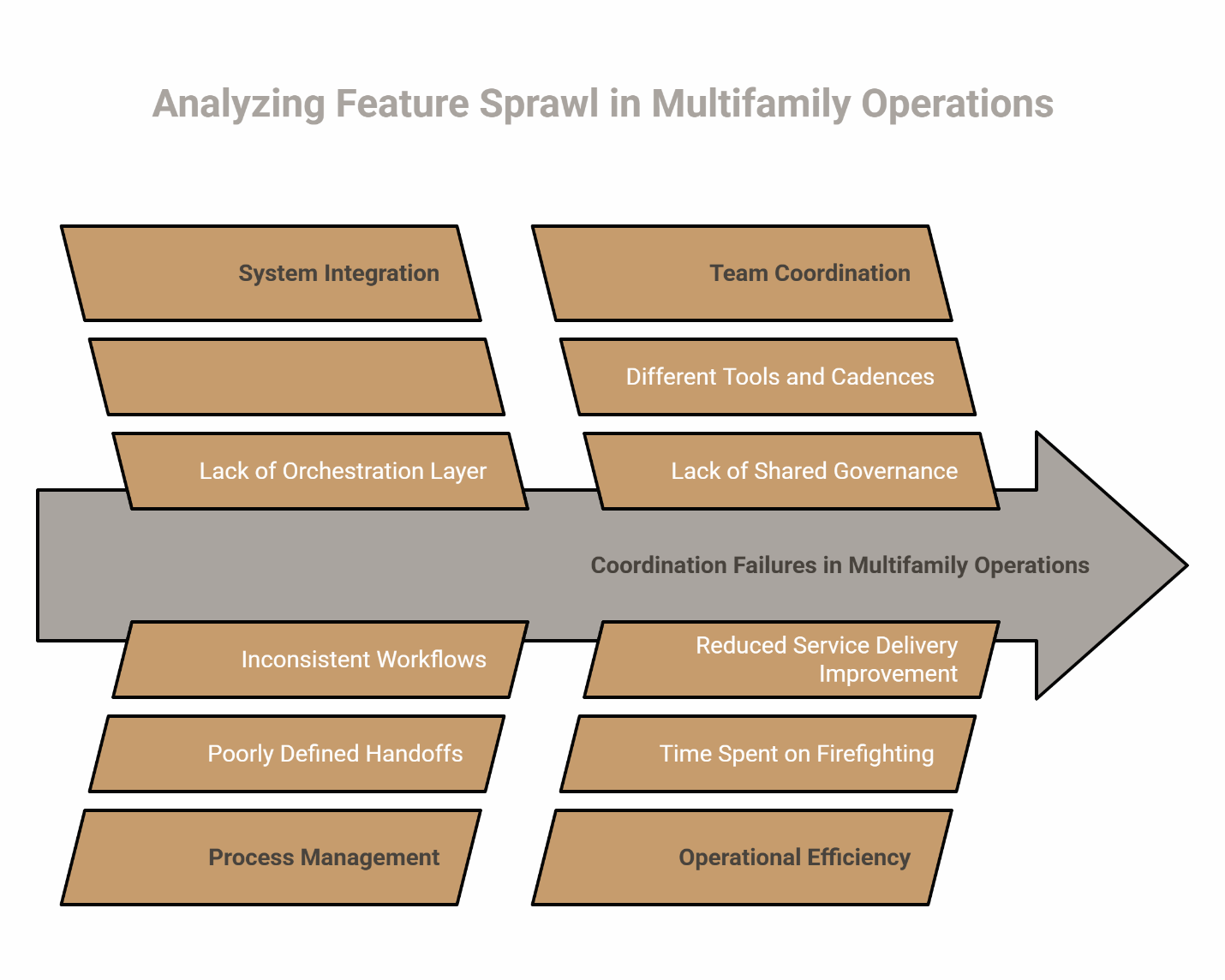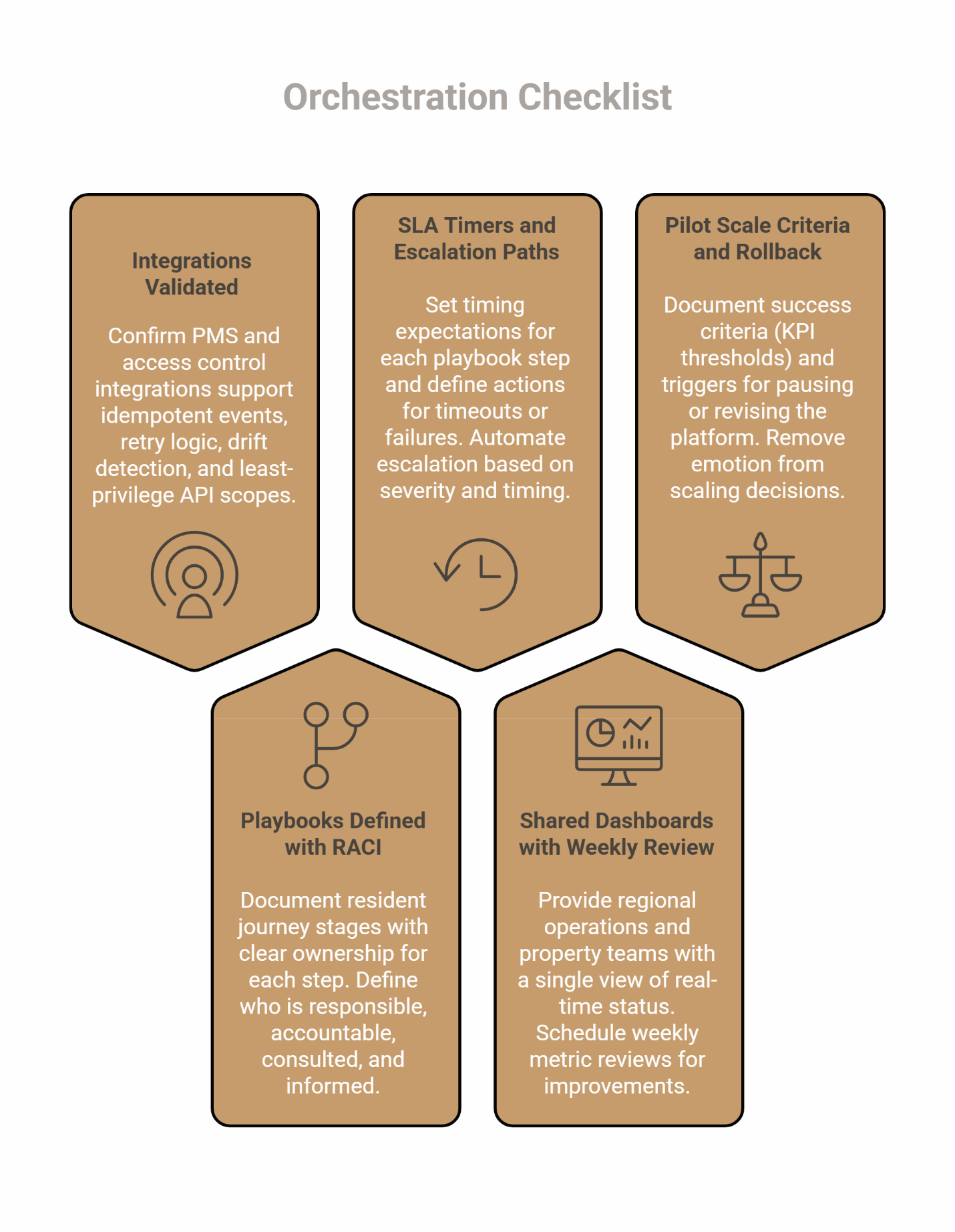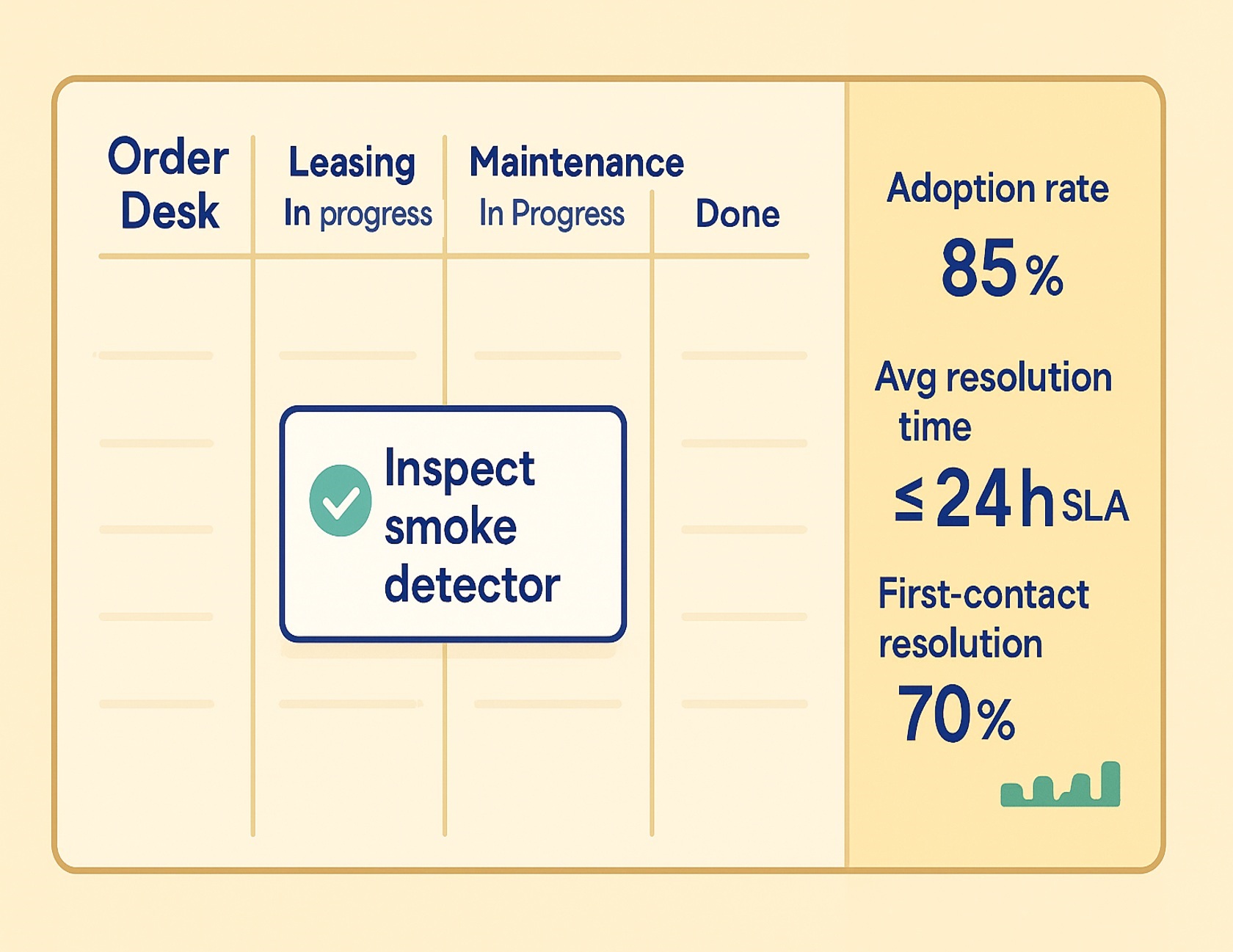
📌 Key Takeaways
Multifamily operations falter not from weak features, but from broken coordination between them—and the control-tower model fixes that at the system level.
- Orchestration Outperforms Feature Count: Standardized playbooks with event-timed triggers across PMS, access control, and messaging prevent SLA breaks before residents experience problems.
- Integrations Are the Foundation: Idempotent events, retry logic, drift detection, and least-privilege API scopes must be validated before any orchestration layer can reliably coordinate cross-system workflows.
- Pilot-First Reduces Risk: A 30-60 day pilot with clear RACI, weekly metric cadence, and predefined scale criteria builds confidence through measurable leading indicators rather than requiring company-wide transformation.
- Leading Indicators Drive Action: First-response time, resolution SLA adherence, and escalation rates predict renewal outcomes while giving operations teams time to correct course before commitments break.
- The Matrix Clarifies Trade-offs: Feature sprawl optimizes tasks but breaks handoffs; monolithic suites reduce vendors but limit flexibility; IT-led builds create maintenance burden; orchestration platforms coordinate outcomes when integrations are reliable.
Coordination turns chaos into measurable, SLA-driven operations. Regional VPs and Directors of Operations in U.S. Class A multifamily will find the strategic framework here, preparing them for the control-tower implementation details that follow.
The monthly chaos hits like clockwork. It's the 28th, and your property teams are managing peak move-ins across five buildings. The PMS shows leases signed and units ready, but access credentials haven't synced. Residents arrive to locked doors. Work orders multiply. Your regional operations dashboard lights up with escalations, and what should have been a smooth transition becomes an SLA breach that ripples through your renewal metrics.
This isn't a staffing problem or a training gap. It's the predictable outcome of feature sprawl—a stack of disconnected point solutions that each optimize a single task while creating coordination failures across the resident journey. What multifamily operations need isn't more features. It's orchestration: a unified operational layer that coordinates tasks, data, and roles from a single command center.
Think of it like air traffic control. An airport doesn't get safer by adding more aircraft or more sophisticated landing gear. It gets safer when a control tower coordinates every plane, runway, and service vehicle according to standardized protocols with clear accountability. A unified resident experience platform serves as that control tower, orchestrating workflows with standardized playbooks, identity-aware triggers, and cross-property dashboards that keep SLAs green and teams aligned.
What Feature Sprawl Looks Like in Multifamily

Feature sprawl emerges when operations teams solve problems by adding specialized applications: one app for access control, another for resident messaging, a third for work orders, a fourth for payments, and yet another for move-in coordination. Each tool excels at its specific function, but the handoffs between them rely on manual coordination and double data entry.
The failure mode is consistent. A lease signing event occurs in the PMS at 3:47 PM on Friday. The access control system, operating on its own polling schedule, doesn't pick up the change until Monday morning. The resident arrives Saturday expecting their credentials to work. They can't enter the building. A frantic call to the weekend property manager triggers a manual override, a work order gets opened retroactively to document the issue, and an escalation email lands in your regional operations inbox.
Each system performed its job correctly in isolation, but because no orchestration layer coordinated the timing, sequence, and ownership of these interdependent steps, the resident experience broke at the seam between systems. This coordination challenge is well-documented in organizational research—cross-functional work consistently degrades without shared workflows and clear governance, particularly when teams operate with different tools and success metrics.
From App Fatigue to Unified Experience
The challenge many property managers face is that residents are overwhelmed by app fatigue—downloading separate apps for rent payment, amenity booking, service requests, and community events. Leading properties are solving this by consolidating everything into a single, white-labeled resident app. This approach not only reduces friction for residents but also gives property managers deeper insights into engagement that traditional PMS systems don't provide on their own.
Modern platforms now offer hotel-style concierge services—from housekeeping to dog grooming—directly through the resident app, creating convenience that keeps residents from looking elsewhere. By consolidating 7+ separate tools into one branded platform, properties eliminate resident app fatigue while reducing vendor management overhead for operations teams. Professional event planning services managed by dedicated teams take the burden off property managers while creating the community experiences that drive retention.
Orchestration: The Control-Tower Model
Orchestration introduces a command layer that sits above your existing systems and coordinates resident events across them. When a "lease signed" event fires, the platform doesn't just log it—it triggers a sequence of actions based on pre-configured playbooks that define timing, ownership, and escalation paths.
Here's what that looks like in practice. The PMS sends a lease-signed webhook to the orchestration platform at 3:47 PM Friday. The platform immediately initiates the resident onboarding playbook: it provisions identity credentials, activates building access with a start date matching the lease, queues a welcome message sequence timed to the move-in date, and assigns pre-move-in tasks to the property team with 48-hour SLA timers.
If any step fails or times out, the platform logs the exception and escalates according to predefined rules—before the resident ever experiences a problem. This resilience comes from idempotent event handling, which ensures that if a message needs to be replayed due to network issues, it won't create duplicate actions or corrupt data.
Integration with Leading PMS Platforms
The orchestration layer integrates directly with enterprise-grade property management systems, pulling lease events, resident data, and unit status in real time. These integrations transform your existing PMS from a system of record into an active participant in orchestrated workflows. When a lease status changes in your property management system, that event triggers coordinated actions across access control, messaging, and concierge services—all without property managers manually updating multiple systems.
The regional operations dashboard shows real-time status across all properties: which move-ins are on track, which are approaching SLA thresholds, and where manual intervention might be needed. This visibility relies on clear service level indicators (SLIs) that feed into service level objectives (SLOs), which in turn define the service level agreements (SLAs) you monitor. As Google's Site Reliability Engineering framework demonstrates, this hierarchy helps teams distinguish between what they measure, what they target, and what they promise—making it possible to intervene early rather than react to broken commitments.
This is the control-tower model: a single operational layer with visibility across all touchpoints, standardized playbooks that encode your operating procedures, and timing-driven automation that prevents coordination failures rather than reacting to them.
Integrations First, Then Orchestration
Orchestration only works if the underlying integrations are reliable. Think of integrations as the arteries that carry information between systems. Before you can orchestrate resident journeys, you need validated data flows between your PMS, access control system, and communication platforms.
What does "reliable" mean? It means idempotent events that can be safely replayed if network issues occur. It means retry logic and queue-based processing so temporary failures don't create permanent data loss. It means drift detection that flags when systems have fallen out of sync. And critically, it means least-privilege API scopes so each integration has only the permissions it needs to perform its function. This principle is foundational for enterprise integrations and aligns with recognized security frameworks.
Most orchestration failures trace back to integration gaps: timing delays between systems, missing error handling, or overly permissive access scopes that create security exposure. Getting the integrations right is prerequisite work.
Features Don't Equal Outcomes: Why Coordination Wins
Adding more features doesn't improve outcomes if those features can't coordinate with each other. A resident doesn't experience "access control" and "move-in communication" and "work order management" as separate services—they experience a single journey that either works seamlessly or breaks at the handoffs.
Standardized operating playbooks combined with event-timed orchestration improve SLA adherence and renewal indicators. When every move-in follows the same sequence with the same timing and the same accountability, variance drops. Property managers stop reinventing the process each time. Regional operations can measure performance consistently across portfolios. And critically, you can identify systemic issues early through shared dashboards rather than discovering problems only when they escalate.
The weekly metric cadence matters here. When you review first-response times, resolution SLAs, and escalation rates every week, you catch drift while it's still correctable. A property that's trending toward threshold violations gets coaching before SLAs actually break. A playbook that's consistently triggering manual overrides gets refined.
Decision Matrix: Four Paths Forward
When evaluating how to address coordination failures in resident operations, you're choosing between four distinct approaches.
Feature Sprawl (Status Quo)
- What Improves: Fast access to best-of-breed tools
- What Breaks: Handoffs between systems; accountability for resident journeys
- Pilotability: Difficult without changing architecture
- SLA Impact: Variable and hard to measure
Monolithic Suite
- What Improves: Single vendor relationship; unified UI
- What Breaks: Access to best-of-breed functionality; flexibility
- Pilotability: Variable—depends on vendor architecture
- SLA Impact: Better coordination potential, limited by suite capabilities
IT-Led Custom Integration
- What Improves: Bespoke workflows matching exact processes
- What Breaks: Speed to value; operational focus delayed by build cycles
- Pilotability: Unclear—depends on dev velocity
- SLA Impact: Eventually strong if build succeeds, but long timeline
Orchestration Platform (Recommended)
- What Improves: End-to-end journey outcomes; SLA governance; cross-property consistency
- What Breaks: Success depends on integration reliability and playbook design
- Pilotability: High—designed for phased rollout with clear metrics
- SLA Impact: Directly measured and continuously improved
Table: Comparison of four approaches across improvement areas, risks, pilotability, and SLA impact for multifamily resident operations.
The orchestration path gives you the control-tower benefits without forcing you to abandon your existing best-of-breed systems or take on a multi-year custom build. But it requires you to invest in the prerequisite integration work first.
What Orchestration Looks Like in Practice
For property managers and regional operations teams, orchestration transforms daily workflows from reactive firefighting to proactive management. Instead of residents downloading separate apps for payments, amenities, and maintenance requests, they interact with a single branded platform that feels native to their community. Behind that unified interface, the orchestration layer is coordinating data flows between your PMS, access systems, and service providers.
When a resident books a community space through the app, the platform automatically checks availability across your calendar system, reserves the space, sends confirmation with access instructions, and notifies the property team if setup is required—all without manual handoffs. When they request a concierge service like housekeeping or pet care, the platform routes the request to the appropriate vendor, tracks completion, and logs the interaction for future engagement insights.
This consolidated experience reduces the vendor management burden on your operations team while giving you visibility into resident engagement patterns that inform retention strategies. You're no longer managing seven separate vendor relationships and reconciling data across disconnected platforms.
Pilot-First: Turning the Mindset into Action
Adopting the control-tower model doesn't require a company-wide rollout or a multi-quarter implementation. It requires a pilot structured to measure confidence, not perfection.
"Pilots measure confidence, not perfection."
Start with a pilot charter that defines three things clearly: the roles involved (RACI for each journey stage), the KPIs you'll measure weekly, and the risks you're explicitly managing. Choose a single resident journey—move-ins are typically the highest-value starting point—and a small cohort of properties where you can monitor results closely.
Configure your playbooks with SLA timers and escalation paths from day one. Run a weekly metric cadence. Review first-response times, resolution SLAs, escalation rates, and early renewal signals. Compare pilot properties to your baseline. Define your scale criteria in advance: What threshold of improvement justifies expanding to more properties? When integrations already exist and have been validated, you can typically pilot orchestration within 30 to 60 days.
Metrics That Matter
Not all metrics are equally useful for measuring orchestration impact. Lagging indicators like annual renewal rates tell you whether something worked, but they don't give you time to correct course. Leading indicators show you the trend while you can still influence the outcome.
The key is distinguishing between what you measure (service level indicators), what you target internally (service level objectives), and what you promise externally (service level agreements). First-response time measures how quickly the system or team initiates action after a resident request. Resolution SLA adherence tracks what percentage of work orders, access requests, or communication sequences complete within your defined thresholds. Escalation rate shows what percentage of resident interactions require manual intervention or manager involvement.
Resident satisfaction scores and renewal signals are your outcome metrics. They validate that operational improvements are translating to resident experience. But you need the leading indicators above to understand why these outcomes are moving.
The 5-Point Orchestration Checklist

Before you pilot or scale an orchestration platform, verify these five foundational elements are in place:
1. Integrations Validated Confirm that your PMS and access control integrations support idempotent events, implement retry/queue logic for failed calls, detect drift between systems, and use least-privilege API scopes.
2. Playbooks Defined with RACI Document your resident journey stages with clear ownership for each step. Who is responsible, accountable, consulted, and informed? Orchestration automates the handoffs, but you need to define who owns what.
3. SLA Timers and Escalation Paths Configured Set explicit timing expectations for each playbook step and define what happens when a step times out or fails. The platform should escalate automatically based on severity and timing.
4. Shared Dashboards with Weekly Review Cadence Give regional operations and property teams a single pane of glass showing real-time status across all properties. Schedule weekly metric reviews to identify trends and coaching opportunities.
5. Pilot Scale Criteria and Rollback Plan Defined Before you start, document what success looks like (specific KPI thresholds) and what would trigger a pause or major revision. This removes emotion from the scale decision.
Frequently Asked Questions
What is a resident control-tower and how is it different from a portal?
A resident portal is a user interface layer that consolidates access to multiple services. A control-tower platform is an operational layer that orchestrates workflows and coordinates systems behind the scenes. The portal is what residents see; the control tower is what makes sure everything works reliably when they need it.
Do we need to replace our PMS or access control system?
No. Orchestration platforms integrate with your existing systems rather than replacing them. Your PMS remains your system of record for lease data, and your access control system continues managing physical security. The platform coordinates between them so that events in one system trigger appropriate actions in others.
How do we mitigate security risk when connecting these systems?
Start with least-privilege API scopes—each integration should have only the permissions it needs to perform its specific function. Implement comprehensive logging so you have an audit trail of all system interactions. Use token-based authentication with automatic expiration rather than long-lived credentials. Monitor for unusual access patterns or data volumes.
From Chaos to Coordination
The shift from feature sprawl to orchestration is a philosophical change in how you approach resident operations—from optimizing individual tasks to coordinating complete journeys. Your existing systems aren't failures. They're specialized tools that each excel at specific functions. What's been missing is the command layer that coordinates them into a coherent operational system with measurable SLAs and clear accountability.
The path forward starts with validated integrations, moves to pilot-tested playbooks, and scales through measurable improvements in the leading indicators that predict renewal success. When you're ready to explore how orchestration might work in your portfolio, our guides walk through the technical, financial, and operational frameworks in detail.
Disclaimer: The ElevateOS Insights Team produces educational content to help multifamily professionals evaluate emerging operational models and technologies. This article is informational only and not a substitute for professional advice. Evaluate your specific operational requirements, security posture, and vendor ecosystem before implementing any integration or orchestration strategy.

.avif)


